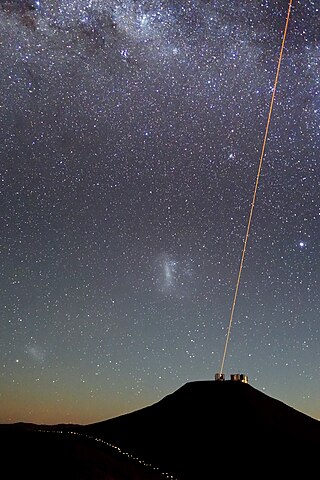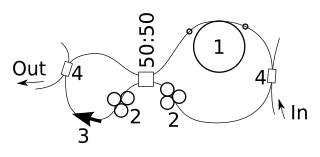Related Research Articles

An optical amplifier is a device that amplifies an optical signal directly, without the need to first convert it to an electrical signal. An optical amplifier may be thought of as a laser without an optical cavity, or one in which feedback from the cavity is suppressed. Optical amplifiers are important in optical communication and laser physics. They are used as optical repeaters in the long distance fiber-optic cables which carry much of the world's telecommunication links.
Responsivity is a measure of the input–output gain of a detector system. In the specific case of a photodetector, it measures the electrical output per optical input.
In physics and many other areas of science and engineering the intensity or flux of radiant energy is the power transferred per unit area, where the area is measured on the plane perpendicular to the direction of propagation of the energy. In the SI system, it has units watts per square metre (W/m2), or kg⋅s−3 in base units. Intensity is used most frequently with waves such as acoustic waves (sound), matter waves such as electrons in electron microscopes, and electromagnetic waves such as light or radio waves, in which case the average power transfer over one period of the wave is used. Intensity can be applied to other circumstances where energy is transferred. For example, one could calculate the intensity of the kinetic energy carried by drops of water from a garden sprinkler.
Optica, founded as the Optical Society of America, is a professional society of individuals and companies with an interest in optics and photonics. It publishes journals, organizes conferences and exhibitions, and carries out charitable activities.
Quantum optics is a branch of atomic, molecular, and optical physics dealing with how individual quanta of light, known as photons, interact with atoms and molecules. It includes the study of the particle-like properties of photons. Photons have been used to test many of the counter-intuitive predictions of quantum mechanics, such as entanglement and teleportation, and are a useful resource for quantum information processing.
In optics, an ultrashort pulse, also known as an ultrafast event, is an electromagnetic pulse whose time duration is of the order of a picosecond or less. Such pulses have a broadband optical spectrum, and can be created by mode-locked oscillators. Amplification of ultrashort pulses almost always requires the technique of chirped pulse amplification, in order to avoid damage to the gain medium of the amplifier.

A blue laser emits electromagnetic radiation with a wavelength between 400 and 500 nanometers, which the human eye sees in the visible spectrum as blue or violet.
SPIE is an international not-for-profit professional society for optics and photonics technology, founded in 1955. It organizes technical conferences, trade exhibitions, and continuing education programs for researchers and developers in the light-based fields of physics, including: optics, photonics, and imaging engineering. The society publishes peer-reviewed scientific journals, conference proceedings, monographs, tutorial texts, field guides, and reference volumes in print and online. SPIE is especially well-known for Photonics West, one of the laser and photonics industry's largest combined conferences and tradeshows which is held annually in San Francisco. SPIE also participates as partners in leading educational initiatives, and in 2020, for example, provided more than $5.8 million in support of optics education and outreach programs around the world.

A virtual retinal display (VRD), also known as a retinal scan display (RSD) or retinal projector (RP), is a display technology that draws a raster display directly onto the retina of the eye.

A distributed Bragg reflector (DBR) is a reflector used in waveguides, such as optical fibers. It is a structure formed from multiple layers of alternating materials with different refractive index, or by periodic variation of some characteristic of a dielectric waveguide, resulting in periodic variation in the effective refractive index in the guide. Each layer boundary causes a partial reflection and refraction of an optical wave. For waves whose vacuum wavelength is close to four times the optical thickness of the layers, the interaction between these beams generates constructive interference, and the layers act as a high-quality reflector. The range of wavelengths that are reflected is called the photonic stopband. Within this range of wavelengths, light is "forbidden" to propagate in the structure.

An optical fiber, or optical fibre, is a flexible glass or plastic fiber that can transmit light from one end to the other. Such fibers find wide usage in fiber-optic communications, where they permit transmission over longer distances and at higher bandwidths than electrical cables. Fibers are used instead of metal wires because signals travel along them with less loss and are immune to electromagnetic interference. Fibers are also used for illumination and imaging, and are often wrapped in bundles so they may be used to carry light into, or images out of confined spaces, as in the case of a fiberscope. Specially designed fibers are also used for a variety of other applications, such as fiber optic sensors and fiber lasers.
In laser science, the beam parameter product (BPP) is the product of a laser beam's divergence angle (half-angle) and the radius of the beam at its narrowest point. The BPP quantifies the quality of a laser beam, and how well it can be focused to a small spot.

Fiber-optic communication is a method of transmitting information from one place to another by sending pulses of infrared or visible light through an optical fiber. The light is a form of carrier wave that is modulated to carry information. Fiber is preferred over electrical cabling when high bandwidth, long distance, or immunity to electromagnetic interference is required. This type of communication can transmit voice, video, and telemetry through local area networks or across long distances.
Thermal blooming or thermal lensing occurs when high-energy laser beams propagate through a medium. It is the result of nonlinear interactions that occur when the medium is heated by absorbing a fraction of the radiation, causing a "thermal lens" to form, with a dioptric power related to the intensity of the laser, among other factors. The amount of energy absorbed is a function of the laser wavelength. The term "thermal blooming" is typically used when the medium is air, and can describe any type of self-induced "thermal distortion" of laser radiation. The term "thermal lensing" is typically used when describing thermal effects in the laser's gain medium itself.
An acousto-optic deflector (AOD) is a device that uses the interaction between sound waves and light waves to deflect or redirect a laser beam. AODs are essentially the same as acousto-optic modulators (AOMs). In both an AOM and an AOD, the amplitude and frequency of different orders are adjusted as light is diffracted.
An ultrashort pulse laser is a laser that emits ultrashort pulses of light, generally of the order of femtoseconds to one picosecond. They are also known as ultrafast lasers owing to the speed at which pulses "turn on" and "off"—not to be confused with the speed at which light propagates, which is determined by the properties of the medium, particularly its index of refraction, and can vary as a function of field intensity and wavelength.
Phosphate glass is a class of optical glasses composed of metaphosphates of various metals. Instead of SiO2 in silicate glasses, the glass forming substrate is P2O5.

Robert Louis Byer is a physicist. He was president of the Optical Society of America in 1994 and of the American Physical Society in 2012.
In the term mode coupling, as used in physics and electrical engineering, the word "mode" refers to eigenmodes of an idealized, "unperturbed", linear system. The superposition principle says that eigenmodes of linear systems are independent of each other: it is possible to excite or to annihilate a specific mode without influencing any other mode; there is no dissipation. In most real systems, however, there is at least some perturbation that causes energy transfer between different modes. This perturbation, interpreted as an interaction between the modes, is what is called "mode coupling".

A figure-8 laser is a fiber laser with a figure-8-shaped ring resonator. It is used for making pico- and femtosecond soliton pulses. The typical spectrum of such a laser consists of a wide central peak and a few narrow lateral peaks that are placed symmetrically around it. The amplitudes of the narrow peaks are the same as or less than that of the central peak.
References
- ↑ "RP Photonics Encyclopedia" . Retrieved 12 February 2020.
- ↑ Paschotta, Rüdiger (2008). Encyclopedia of Laser Physics and Technology (illustrated ed.). John Wiley & Sons. ISBN 978-3-527-40828-3.
- ↑ "RP Photonics Buyer's Guide". RP Photonics. Retrieved 12 February 2020.
- ↑ "The Photonics Spotlight". RP Photonics. Retrieved 12 February 2020.
- ↑ "Glosssary of Photonics Terms". RP Photonics. Retrieved 12 February 2020.
- ↑ "Free Tutorials and Case Studies from RP Photonics". RP Photonics. Retrieved 1 October 2024.
- ↑ "Photonics Quiz". RP Photonics. Retrieved 12 February 2020.
- ↑ "The Company – Basic Facts". RP Photonics. Retrieved 5 March 2024.